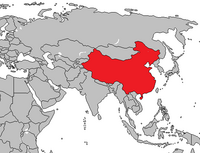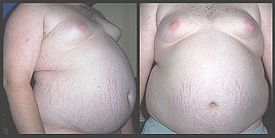Atheism And Physical Fitness
 From Conservapedia
From Conservapedia Below is various resources on atheism and physical fitness.
Contents
- 1 Atheism and sedentary lifestyles
- 1.1 Atheism, motivation, exercise and dopamine levels in the brain
- 1.2 Irreligion/nonreligious regions and sedentary behavior
- 1.2.1 East Asian atheists and sedentary lifestyles
- 1.2.2 Secular Europe and sedentary lifestyles
- 1.2.3 Australia and sedentary lifestyles
- 2 Atheism and obesity
- 3 Sports performance: Religious faith vs. atheism
- 3.1 Atheism and sports performance
- 4 Muscular Christianity
- 4.1 Quote relating to Muscular Christianity
- 4.2 Chuck Norris on the topic of obesity
- 5 See also
- 6 Notes
Atheism and sedentary lifestyles[edit]
See also: Atheism and sedentary lifestyles

The journal article Spirituality and Physical Activity and Sedentary Behavior among Latino Men and Women in Massachusetts which was published in the journal Ethnicity and Disease declared: "There is a significant negative relationship between spirituality and sedentary behavior."[2]
In addition, numerous studies report that athletes to be more religious than non-athletes.[3] See also: Sports performance: Religious faith vs. atheism
Sedentary lifestyles reduce life expectancy.[4] Religion/spirituality is positively correlated to greater longevity (see: Atheism and life expectancy).
Atheism, motivation, exercise and dopamine levels in the brain[edit]
See also: Atheism and the brain and Atheism and motivation
According to Scientific American: "Research also suggests that a religious brain exhibits higher levels of dopamine, a hormone associated with increased attention and motivation."[5] See also: Atheism and the brain and Atheism and motivation
According to WebMD:
| “ | You know exercise is good for you. Doing it, though, is another thing.
To stick with an exercise routine, you need to get out there when that little voice inside you says, "I'll do that tomorrow. Or the day after -- maybe." Motivation does that, and it's not about just powering through.[6] |
” |
Irreligion/nonreligious regions and sedentary behavior[edit]
The current atheist population mostly resides in East Asia (particularly China) and in secular Europe/Australia among whites.[7] See: Western atheism and race and Atheist population and Global atheism
East Asian atheists and sedentary lifestyles[edit]
See also: Asian atheism and China and atheism

Razib Khan points out in Discover Magazine, "most secular nations in the world are those of East Asia, in particular what are often termed 'Confucian societies'. It is likely therefore that the majority of the world’s atheists are actually East Asian."[9]
China has the world's largest atheist population.[10][11] See also: China and atheism
China Daily reported in 2017:
| “ | IN ONE PREFECTURE-LEVEL CITY nearly 57 percent of those applying to join the armed forces have failed their health test so far this year. Beijing Youth Daily commented on Monday:
That so many potential recruits failed the fitness test reveals the worrying fact that unhealthy lifestyles have taken a toll on many Chinese youngsters.[12] |
” |
The Journal of Sport and Health Science reported in 2016:
| “ | Three decades of open reforms in China have brought significant changes in industrialization and urbanization, which have begun to exert an impact on the living environment, health care, and lifestyles. The unprecedented economic development has also brought with it an increase in both the burden of noncommunicable diseases (e.g., coronary heart disease, stroke, hypertension, cancer, and type 2 diabetes) and unhealthy lifestyles (e.g., physical inactivity, fatty food intake, and smoking) among the Chinese population. Physical inactivity, which has been recognized as a high risk factor for disease—contributing 12%–19% of the risk associated with major noncommunicable diseases — has been on the rise in China and was responsible for at least 15% of health care-related costs of major diseases in 2007. This situation has created an urgent need for primary prevention efforts aimed at promoting an active lifestyle, including physical activity (PA), and preventing noncommunicable diseases among the aging Chinese population.[13] | ” |
Secular Europe and sedentary lifestyles[edit]

In 2019, the World Health Organization (WHO) declared:
| “ | In the WHO European Region, one in five people takes little or no physical activity, with higher levels of inactivity in eastern countries. In the European Union (EU), two thirds of the adult population does not reach recommended levels of activity. As a result, physical inactivity is estimated to deprive Europeans of over 8 million days of healthy life every year, on average. Everybody is not affected in the same way, however.
Maintaining sufficient levels of physical activity is becoming more and more difficult, as most daily environments have changed significantly in recent years. The causes of physical inactivity are predominantly the result of systemic and environmental factors, which have made daily living and working environments increasingly sedentary. Greater distances between homes, workplaces, shops and places for leisure activities have increased the use of cars and led to a decline in walking and cycling. Simultaneously, in many contexts, road safety remains a concern, whereby it is, or is perceived to be, not safe to engage in active transport. Children and adolescents spend more time in school or day-care settings than ever before; academic demands are increasing, which can reduce the time dedicated to physical education and active play. [15] |
” |
Australia and sedentary lifestyles[edit]
See also: Irreligion in Australia

After WWII, Australia has become a very secular country.[17]
According to the Sydney Morning Herald:
| “ | Australia is one of the least devout countries in the Western world, although two-thirds of its population identifies itself as Christian, an international survey comparing religious expression in 21 countries has found.
Religion does not play a central part in the lives of many Australians: 48 per cent of Australians surveyed said they did not partake in personal prayer and 52 per cent said they rarely attended a place of worship for religious reasons.[18] |
” |
According to the Heart Foundation, Australia:
| “ | In 2014/15, 65.3% of Australians aged 15 and over were sedentary or had low levels of exercise (comprised of 33.8% sedentary and 31.5% low levels of exercise).
In total, 12 million Australians aged 15 and over had either sedentary or low levels of exercise.[19] |
” |
Atheism and obesity[edit]
See also: Atheism and obesity

As noted above, the current atheist population mostly resides in East Asia (particularly China) and in secular Europe/Australia primarily among whites.[21] Most atheists are East Asians (see: Asian atheism). See: Global atheism and Western atheism and race
Secular Europe and communist China have significant problems with obesity (see: Secular Europe and obesity and China and obesity). In addition, Australia has a significant problem with obesity (see: Australia, irreligion and obesity).
In the United States at the present time, the greater the degree of irreligiosity in a generation, the higher their obesity rate is.
According to the Gallup Inc., "Very religious Americans are more likely to practice healthy behaviors than those who are moderately religious or nonreligious."[22]
Gallup declared concerning the study which measured the degree to which religiosity affects health practices: "Generalized linear model analysis was used to estimate marginal scores all five reported metrics after controlling for age (in years), gender, race/ethnicity, marital status, education (number of years), log of income, and region of the country... Results are based on telephone interviews conducted as part of the Gallup-Healthways Well-Being Index survey Jan. 2-July 28, 2010, with a random sample of 554,066 adults, aged 18 and older, living in all 50 U.S. states and the District of Columbia, selected using random-digit-dial sampling.[23]
Sports performance: Religious faith vs. atheism[edit]
See also: Sports performance: Religious faith vs. atheism
The Sports Journal is a monthly refereed journal published by the United States Sports Academy. A journal article appeared in the Sports Journal entitled Strength of Religious Faith of Athletes and Nonathletes at Two NCAA Division III Institutions. The article was submitted by Nathan T. Bell, Scott R. Johnson, and Jeffrey C. Petersen from Ball State University.[24]
An excerpt from the abstract of the journal article Strength of Religious Faith of Athletes and Nonathletes at Two NCAA Division III Institutions declares:
| “ | Numerous studies report athletes to be more religious than nonathletes (Fischer, 1997; Storch, Kolsky, Silvestri, & Storch, 2001; Storch et al., 2004). According to Storch, Kolsky, Silvestri, and Storch (2001), four reasons may explain why religion interacts with athletic performance. First, athletes may identify with religious beliefs for direction and humility. Second, athletes may turn to religion to gain a sense of optimism and security, benefiting from such beliefs following a disappointing athletic performance. Third, religion can be used for emotional and psychological support in stressful circumstances like the uncertainty of athletic competition, which can cause athletes an overwhelming amount of anxiety. Religious beliefs can offer the internal strength to persevere through the stress. Fourth, religion “provides a cognitive framework conducive to the relief of anxiety associated with competition” (Storch et al., 2001, p. 347). This framework allows relief from fear and anxiety on the basis of the athlete’s understanding (i.e., belief) that a supreme being is in complete control of the situation. For example, athletes may rely on religious faith to place a poor athletic performance in perspective...
Religion can be an important aspect in athletes’ lives and may serve a protective function against psychological distress and maladaptive behaviors such as substance use or aggression (Storch, Roberti, Bravata, & Storch, 2004). Viewers of sporting events can frequently observe athletes pointing to the sky, engaging in team prayer on the court or field, and glorifying God following athletic competitions.[25] |
” |
Atheism and sports performance[edit]
Besides lacking the aforementioned benefits that religion bestows on athletes, atheists have higher rates of depression and suicide than the religious (see: Atheism and health and Atheism and depression and Atheism and suicide). This suggests that atheism is detrimental to sports performance.
Muscular Christianity[edit]
See also: Muscular Christianity

Brett and Kate McKay wrote:
| “ | Historian Clifford Putney defines Muscular Christianity “as a Christian commitment to health and manliness,” and as a label and a philosophy, it originated in England in the 1850s, growing out of the novels of Thomas Hughes (Tom Brown’s School Days) and Charles Kingsley (Westward Ho!). Both men believed the Anglican Church was becoming too soft and effeminate, and created protagonists in their books who embodied an ideal counterbalance — young men who managed to combine the virtue and ethics of gentlemanly Christians, with masculine athleticism, camaraderie, and honor.
While Muscular Christianity took off first in England because industrialization and urbanization (and accompanying concerns about a decline in manliness) occurred earlier there than in the States, it eventually migrated to American shores in the 1870s. And here the movement would find an even greater and longer-lasting impact; it remained popular from around 1880 until 1920, and as we’ll see later, continues to influence American culture today.[28] |
” |
Quote relating to Muscular Christianity[edit]
See also: YMCA
“Among all the marvelous advances of Christianity either within this organization [the YMCA] or without it, in this land and century or any other lands and ages, the future historian of the church of Christ will place this movement of carrying the gospel to the body as one of the most epoch making.” –G. Stanley Hall, “Christianity and Physical Culture” (1901)
Chuck Norris on the topic of obesity[edit]
See also: Chuck Norris on the topic of obesity

In April of 2011, the conservative Christian Chuck Norris wrote:
| “ | The problems with being overweight and obese go far beyond looks. They affect our mentality, mobility and can lead to a number of physical diseases and ailments...
It's true that genetics, environment, socio-economic status, metabolism and behavior can be contributors to these ailments. But the fact is most Americans are overweight and obese because they eat poorly and don't exercise. Most of our foods are super high in fats, sugars and salt. And, compared to other countries, we eat much larger portions. We live to eat – most other cultures eat to live. The primary reason obesity statistics and these subsequent illnesses are so high is that our culture is entrenched in hedonism, which means we are all about pleasure. We go where we feel like going. We do what we feel like doing. We watch what we feel like watching. And we eat what we feel like eating. And God help the soul who tells us to do otherwise... ... We think doing what we feel like doing is power and freedom, when really it's just carrying out what our flesh craves. True freedom is being able to look straight in the eye of what you feel like doing (even if it's wrong) and possessing the power to say no. Eating what we want isn't liberty – that's tyranny. Eating what is right is freedom – that's victory over oppression. And triumph over the tummy should be our next battle. Fighting for a better America includes fighting for a healthier, fitter, combat-ready you. (That is why my new cultural warrior book, "Black Belt Patriotism," contains an entire chapter on helping you win the consumption war and not just the culture wars."[30] |
” |
See also[edit]
- Atheism and health
- Atheists and physical attractiveness
- Atheist nerds
Notes[edit]
- ↑ Strength of Religious Faith of Athletes and Nonathletes at Two NCAA Division III Institutions
- ↑ Spirituality and Physical Activity and Sedentary Behavior among Latino Men and Women in Massachusetts by Valerie J. Silfee, Christina F. Haughton, Stephenie C. Lemon, Vilma Lora, and Milagros C. Rosal, Ethnicity and Disease. 2017 Winter; 27(1): 3–10. Published online 2017 Jan 19. doi: 10.18865/ed.27.1.3
- ↑ Strength of Religious Faith of Athletes and Nonathletes at Two NCAA Division III Institutions
- ↑ Height and Weight May Determine How Long You Can Live—Especially If You're a Woman
- ↑ Ask the Brains, Scientific American, Dec 23, 2011
- ↑ 10 Ways to Boost Your Exercise Motivation By Virginia Anderson, WebMD
- ↑ A surprising map of where the world’s atheists live, By Max Fisher and Caitlin Dewey, Washington Post, May 23, 2013
- ↑ Sedentary lives make many unfit for service, China Daily, 2017
- ↑ Most atheists are not white & other non-fairy tales, Discover magazine
- ↑ Top 50 Countries With Highest Proportion of Atheists / Agnostics (Zuckerman, 2005)
- ↑ A surprising map of where the world’s atheists live, Washington Post By Max Fisher and Caitlin Dewey May 23, 2013
- ↑ Sedentary lives make many unfit for service, China Daily, 2017
- ↑ Physical activity among older Chinese adults living in urban and rural areas: A review by Wenfei Zhu, Aiping Chi Yuliang Sun, Journal of Sport and Health Science Volume 5, Issue 3, September 2016, Pages 281-286
- ↑ Europe and sedentary lifestyles, World Health Organization, accessed 3-27-2019
- ↑ Europe and sedentary lifestyles, World Health Organization, accessed 3-27-2019
- ↑ Heart Foundation Australia - Level of exercise statistics
- ↑ Stephanie Painter, Vivienne Ryan and Bethany Hiatt, (15 June 2010). "Australians losing the faith". Newspaper. West Australian Newspapers Ltd. Retrieved 15 June 2010
- ↑ God's OK, it's just the religion bit we don't like
- ↑ Heart Foundation Australia - Level of exercise statistics
- ↑
- Causes of obesity - Mayo Clinic
- How much exercise is needed to get fit and lose weight
- Genes Are Not Destiny - Harvard University School of Public health
- The 6 Weight-Loss Tips That Science Actually Knows Work - Forbes, April 9, 2013
- Long-term weight loss maintenance, American Journal of Clinical Nutrition, 2005 July; 82(1 Suppl):222S-225S.
- Strength Training For Weight Loss Success by Deborah L. Mullen, CSCS
- Weight loss strategies for success - Mayo Clinic
- ↑ A surprising map of where the world’s atheists live, By Max Fisher and Caitlin Dewey, Washington Post, May 23, 2013
- ↑ Very Religious Americans Lead Healthier Lives, Gallup Poll, 2010
- ↑ Very Religious Americans Lead Healthier Lives, Gallup Poll, 2010
- ↑ Strength of Religious Faith of Athletes and Nonathletes at Two NCAA Division III Institutions
- ↑ Strength of Religious Faith of Athletes and Nonathletes at Two NCAA Division III Institutions
- ↑ http://www.totalgymdirect.com/
- ↑ Chuck Norris article on atheism
- ↑ When Christianity Was Muscular by BRETT AND KATE MCKAY
- ↑ http://en.wikipedia.org/wiki/https://www.conservapedia.com/File:ChuckNorris200611292256.jpg
- ↑ http://www.wnd.com/index.php/index.php?fa=PAGE.printable&pageId=109051
Categories: [Atheism]
↧ Download as ZWI file | Last modified: 02/18/2023 07:34:12 | 12 views
☰ Source: https://www.conservapedia.com/Atheism_and_physical_fitness | License: CC BY-SA 3.0
 ZWI signed:
ZWI signed: KSF
KSF